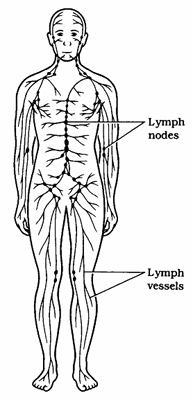Breast Unit
Lymphoedema
The complete document can be downloaded as a PDF document from the link at the end of the page
On this page:
- What is Lymphoedema?
- Understanding the lymphatic system
- How to reduce the risk of developing Lymphoedema
- What to look out for
- Lymphoedema Clinic
- Related Information and Links
What is Lymphoedema
Lymphoedema is a swelling in the tissues below the skin that occurs when the lymphatic fluid cannot drain away. Lymphoedema usually affects an arm but it can happen anywhere on the affected side of your body e.g. chest or back. This can happen if the lymphatic system is damaged or blocked.
Lymph nodes are removed as part of cancer surgery and this can block the normal drainage pathway. Lymphatic vessels and nodes can also be damaged by the cancer and by the scarring that follows after surgery or radiotherapy.

Although this treatment is essential to cure the cancer it may also damage the lymphatic system. Many people experience no problem at all but some develop a swelling known as lymphoedema.
In lymphoedema fluid is dammed behind the blockage and builds up in the surrounding tissues causing swelling.
Lymphoedema may occur immediately after treatment or many years later.
The Lymphatic System
In order to understand lymphoedema you need to know a little bit about the lymphatic system.
The lymphatic system is a network of vessels (tubes) and nodes (glands) that cover the body and drain fluid from the tissues into the blood stream.
The lymph vessels collect extra fluid, protein and waste material from the body tissues and transport it via the lymph nodes back into the blood.
The lymph nodes filter the fluid of any unwanted material and make special cells that help the body fight infection.
How to reduce the risk of developing Lymphoedema
If you have had surgery to remove the lymph nodes from your axilla (armpit) and/or radiotherapy to your axilla you are at risk of developing lymphoedema in your arm or anywhere on the affected side of your chest or back.
There are things that you can do to reduce this risk. You need to follow this simple advice for life as lymphoedema may occur any time after treatment.
- Avoid Infection and Injury
The skin is covered in germs and a break in the skin can let germs in. With fewer lymph nodes there is a decreased ability to fight off germs and this can lead to an increased risk of developing an infection in the affected area. An infection could trigger the start of lymphoedema. So:- Wear long sleeves and gloves when gardening
- Wear gloves for washing up
- Take care when cutting nails
- Wear insect repellent to avoid bites
- Exercise care whilst shaving, always use an electric shaver as razors can cut the skin
- Avoid having injections or blood taken from the affected arm. For people who have had surgery to both armpits blood samples may be obtained from the feet or legs
- Avoid having your blood pressure taken from the affected arm
- Avoid acupuncture to the affected side
- Try to avoid pet scratches
If you do break the skin wash the area carefully, apply an antiseptic e.g. 'savlon', 'germolene', 'tcp' and cover.
Watch for signs of infection: rash, pain, warmth, redness, sudden swelling or fever.
If you have any of these symptoms please consult your GP immediately who will prescribe antibiotics.
Carry antibiotics with you on holiday in case of infection.
- Keep your skin in good condition
Try to keep your skin clean, soft and moisturised. Wash with a mild soap that won't dry your skin. After washing dry thoroughly especially between the fingers. Apply an unperfumed moisturiser e.g. aqueous cream to your skin daily. - Avoid things that are too tight
- Avoid wearing tight sleeves, jewellery, or watches on the affected arm
- Do wear a well fitting bra, preferably one that does not mark the skin or have very thin straps
- Try to carry your handbag on the other shoulder
- Avoid vigorous activity
Exercise is important but don't overdo it!
- Use your arm normally and take regular gentle exercise. Swimming and yoga are good exercises
- Try not to overtire the arm at risk. If it starts to ache, rest
- Avoid vigorous, repetitive weight bearing movements e.g. scrubbing, pushing, and pulling
- Avoid activities which put a heavy strain on your arm such as carrying heavy weights(including children and heavy shopping bags), moving furniture, heavy gardening tasks
Whatever exercise you choose build up the amount gradually. Use your arm as a guide to how much you can do. It is better not to exercise in the heat of the day and be sure to protect yourself from the sun.
Appropriate positioning of the 'at risk' arm whilst at rest will also reduce the likelihood of swelling occurring in the hand and forearm. When sitting, position the arm on the side of the chair rather than letting the arm hang down.
- Avoid Heat
- In hot weather try to stay in the shade or cover up the affected area
- Avoid very hot baths or showers, saunas and hot tubs
- Always wear a high factor sunscreen (SPF15 or above)
- Avoid heat producing ointments i.e. 'Deep Heat' or hot water bottles on the affected side
What to look out for
- A feeling of tightness in your arm
- A feeling of fullness or pressure
- The sensation of swelling which can often be present even before the swelling is seen
- Puffiness, swelling or any increase in the size of your arm or anywhere on that side of your chest or back
- A bursting sensation
- Aching or heaviness in your arm, chest or back
There are several reasons other than lymphoedema which may cause swelling. If you notice any of the signs listed above contact your GP, Consultant or Specialist Nurse who can refer you to the lymphoedema clinic if necessary.
Lymphoedema Advice - download the complete document
Lymphoedema Clinic
Lymphoedema Practitioner
The Lymphoedema Clinic at the RUH
North Wing
Royal United Hospital
Combe Park
Bath
BA1 3NG
Telephone : 01225 821501
www.ruh.nhs.uk/lymphoedema (this link opens a new window)
Further information about the Lymphoedema Clinic
(Link opens in a new window)
Related Information and Links
Lymphoedema Support Network
St. Luke's Crypt
Sydney Street
London
SW3 6NH
Telephone: 020 7351 4480.
www.lymphoedema.org/lsn (external site – opens a new window)
adminlsn@lymphoedema.freeserve.co.uk
Cancerbackup
3 Bath Place
Rivington Street
London
EC2A 3DR
Telephone: 0808 8001234
Cancerbackup (external site – opens a new window)
Lymphoedema Advice - download the complete document


